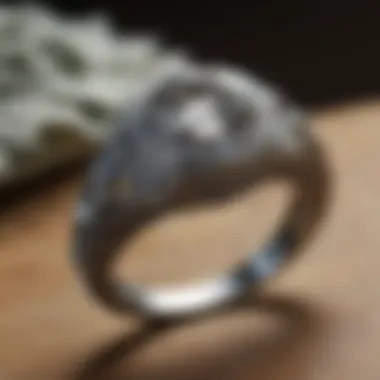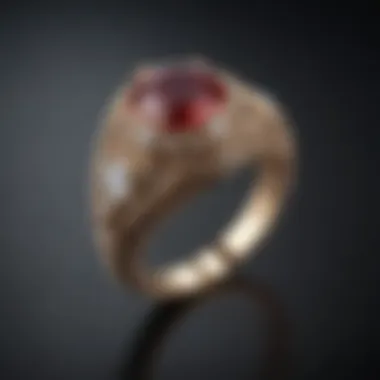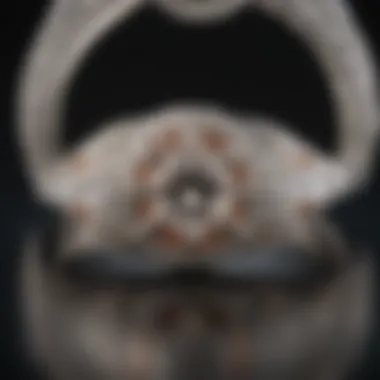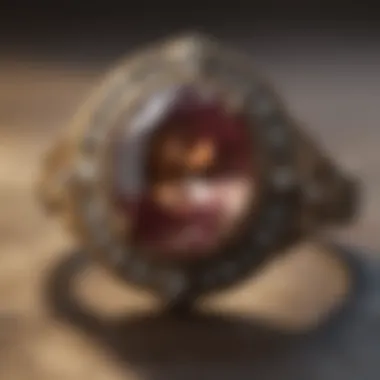Antique Style Engagement Ring Settings Explained


Intro
When it comes to love and commitment, the engagement ring is a powerful symbol. Among the myriad styles available, antique style engagement rings hold a unique charm, instantly transporting the wearer to an era marked by exquisite craftsmanship and intricate detail. These rings are not merely pieces of jewelry; they embody stories of love and history. In this guide, we will traverse the fascinating world of antique style engagement ring settings, delving into their origins, distinctive characteristics, and the appeal that makes them a popular choice today.
To fully appreciate these magnificent pieces, it is essential to understand the gemstone at the heart of many antique rings. The choice of gemstone can dramatically influence the ring's story, value, and sentimental significance. This exploration will enlighten gemstone enthusiasts, collectors, and designers alike, arming them with the knowledge needed to make informed decisions.
Let’s begin our journey by examining the diverse world of gemstones used in these antique treasures.
Intro to Antique Style Engagement Rings
Antique style engagement rings are more than mere adornments; they are testimony to art, history, and emotion. They encapsulate stories long woven into the fabric of time, offering a unique, romantic appeal that contemporary designs often fail to capture. The importance of exploring these rings lies in understanding their variety, craftsmanship, and the emotions they evoke.
When one thinks of antique style, images of detailed workmanship and rich symbolism come to mind. Each piece can reflect a significant period, integrating elements from various cultures and styles that span centuries. Choosing an antique engagement ring means stepping away from the uniformity of modern products and embracing individuality, where every ring carries its own narrative, transforming not just into jewelry but a treasured heirloom. Considerations such as personal aesthetic, historical context, and craftsmanship play an essential role when selecting an antique style ring, making it critical to delve into the various facets this guide offers.
Understanding Antique Aesthetics
In recognizing antique aesthetics, we must appreciate the variety and depth present in each design era. The intricate details often characterize these pieces, showcasing artisanship that’s nearly lost in today’s mass production. Elements like filigree work, milgrain detailing, and unique gemstone settings provide a charm that reflects the personal touch of the creators. Vintage styles invite observation and admiration.
Common design elements:
- Engraving: Often, rings feature delicate engravings, showcasing the skilled hands that crafted them.
- Color: Antique rings come in a rich palette of colors as they incorporate various metals such as rose gold, yellow gold, and platinum.
- Shapes: Non-traditional shapes and settings can better express the wearer’s personality, differing from conventional styles.
Understanding these aspects allows one to appreciate not merely the appearance of the ring, but the effort and expression behind its design.
The Allure of Vintage Jewelry
The allure of vintage jewelry stems largely from its intrinsic connection to history and romance. Each piece can be like a time capsule, preserving thoughts and emotions from the era it hails from. Those willing to wear such jewelry not only adorn themselves but also become part of a broader story.
"When you wear antique jewelry, you wear a piece of history. Each scratch and flaw tells a story of its own!"
The rarity of genuine vintage pieces adds to their appeal. As time passes, the number of existing pieces diminishes. Collectors and enthusiasts often seek these out, crafting narratives around them—stories which can include moments of love, commitment, or even trials of time. Therefore, understanding the magnetic pull of vintage jewelry is crucial for anyone looking to invest in an antique-style engagement ring.
Selecting a ring that resonates personally can achieve emotional significance while celebrating one’s unique identity. It’s a choice filled with intention, ensuring that the eventual engagement ring carries a legacy that endures beyond a single generation.
Historical Context of Antique Engagement Rings
Understanding the historical context of antique engagement rings is crucial for anyone who appreciates the rich tapestry of jewelry craftsmanship. These rings not only represent a romantic commitment but also embody the aesthetics, values, and social norms of their respective eras. Delving into their history allows one to appreciate the evolution of designs and materials, making informed choices about personal jewelry or collections.
Influences from Different Eras
The influence from different periods plays a significant role in shaping what we now consider antique engagement rings. Each era marked a distinct design philosophy and aesthetic execution, which continues to resonate with gem enthusiasts and collectors today.
Georgian Era
In the Georgian Era, roughly spanning from 1714 to 1830, jewelry was heavily influenced by nature. This period is renowned for intricate metalwork and the use of luscious gemstones.
- Key Characteristic: The emphasis on handcrafting meant each piece was unique. The artisans took their time, resulting in a rich detailing that few can replicate today.
- Why it Matters: Rings from this time often showcase a romantic quality with motifs like flowers and foliage that appeal to those looking for something sentimental.
- Unique Feature: One standout element of Georgian jewelry is the use of rose-cut diamonds, which reflect light beautifully yet remain understated. The downside is that the wear and tear of these older pieces can require careful maintenance.
Victorian Era
The Victorian Era, spanning from 1837 to 1901, brought dramatic transformations in both social structures and jewelry design. Influenced by Queen Victoria's own preferences, jewelry became a statement of social status.


- Key Characteristic: This era introduced themes of romanticism with detailed engravings and the use of symbolism—like hearts and lockets—that spoke to deeper meanings.
- Why it Matters: The Victorian emphasis on sentimentality made these rings desirable for couples wanting to express their love.
- Unique Feature: The use of gold became prevalent, with various colors emerging—especially yellow and rose gold. Some disadvantages include the relatively larger size of rings, which may not suit all modern aesthetics.
Edwardian Era
Possibly one of the most glamorous periods, the Edwardian Era (1901-1910) was characterized by intricate lace-like designs in platinum and the increased popularity of diamonds.
- Key Characteristic: The Edwardian style embraced elaborate settings with delicate filigree work, often incorporating color through gemstones like sapphires and emeralds.
- Why it Matters: This period emphasized elegance and delicacy, making these rings timeless pieces often sought after by collectors today.
- Unique Feature: The intricate metalwork can make Edwardian rings appear almost ethereal. However, the use of platinum can be both a strength and a hindrance due to its higher cost and the care required to maintain its shine.
Art Deco Movement
The Art Deco Movement emerged in the 1920s, embracing modernity and geometrical shapes, taking a vibrant turn from previous styles.
- Key Characteristic: Bold designs featuring clean lines and symmetrical forms became the hallmark of this era.
- Why it Matters: Rings from the Art Deco period resonate well with modern sensibilities while incorporating vintage flair.
- Unique Feature: This era favored the use of colored stones, like rubies, sapphires, and emeralds, creating striking contrasts against the sparkling diamonds. Although some might deem the boldness of Art Deco pieces as less subtle than their predecessors, they represent a willingness to break away from tradition.
Cultural Significance of the Engagement Ring
Engagement rings have carried deep cultural meanings throughout history, serving as tokens of commitment, love, and status. Their importance extends beyond simple adornment, often reflecting societal values, family heritage, and personal stories. In many cultures, these rings act as tangible proof of promises made, marrying not just two individuals but also their families and histories. Moreover, the shift in designs over time mirrors changes in social norms and fashion tastes, making the study of these rings a complex blend of artistry and socio-cultural evolution.
The historical context of antique engagement rings provides an avenue to explore not only aesthetics but the very essence of human connection and commitment.
Distinctive Features of Antique Styles
Engagement rings are not just pieces of jewelry; they are deeply rooted in history, culture, and personal narratives. Antique style engagement rings, in particular, stand out due to their unique features that set them apart from modern designs.
When we think about distinctive features, we’re looking at elements that showcase artistry and craftsmanship of bygone eras. An antique ring often carries a story, while modern rings may emphasize meaning or status. The intricate detailing, choice of gemstones, and exquisite settings are some attributes that make antique styles so captivating.
Common Settings in Antique Rings
Prong Settings
Prong settings are a mainstay in the world of engagement rings, especially with antique styles. The hallmark of this setting is simplicity and security. Typically consisting of four to six prongs, these tiny metal claws grip the stone firmly. This not only showcases the brilliance of the gemstone but also raises it slightly above the band, enhancing its visual impact.
Prong settings are often favored for their versatility and the fact that they allow for maximum light to enter the gem, making it sparkle like the night sky. However, one must consider the vulnerability of the stone; if not maintained properly, the prongs might wear down, leading to the loss of a treasured piece.
Bezel Settings
The bezel setting offers a more modern protective aesthetic. In this style, the gemstone is set within a metal rim that encircles its sides. The main characteristic of bezel settings is their ability to shield the gemstone from damage, making them an ideal option for those who lead an active lifestyle.
They lend a streamlined look to the ring, whereby the focus shifts slightly from the stone to the overall design. The downside of bezels is that they can obscure some of the stone's sides, limiting how much light enters the gem, potentially dulling its brilliance. Nevertheless, their practicality and contemporary feel make them a popular choice among antique enthusiasts.
Cluster Settings
Cluster settings are where creativity takes the reigns. This artistic style comprises multiple smaller stones grouped together to create a larger impression. One of the most beloved characteristics of cluster settings lies in their ability to mimic a single, larger center stone while often being more budget-friendly. This attribute opens up a myriad of design possibilities, bridging vintage charm with modern flair.
However, it's essential to think about the upkeep, as multiple stones can mean more surfaces that may require cleaning or might have the potential for being dislodged. Still, the charm and individuality they bring to an antique ring can create a captivating, one-of-a-kind creation.
Types of Gemstones Used
Diamonds
Diamonds have long been the poster child for engagement rings, with their remarkable hardness and timeless elegance. When they grace an antique ring, they often come with a historic cut, such as the old European cut, showcasing an enchanting personality. What makes diamonds appealing in antique styles is their ability to hold a classic allure while still embodying the era's craftsmanship.


However, their rarity and price can be a significant drawback for some, weighing heavily on collectors who are seeking balance between cost and quality. Still, a diamond ring often becomes a family heirloom, steeped in emotional significance.
Sapphires
Sapphires, traditionally associated with nobility, are on the rise within antique style rings. With their stunning range of colors and excellent durability, they make a compelling alternative to diamonds. Vintage designs often feature these gems in a variety of alluring hues, particularly deep blue.
The unique feature of sapphires is their affordability compared to diamonds, allowing couples more creativity in design without breaking the bank. However, potential buyers should be wary of fakes or treatments that might compromise the stone's integrity.
Emeralds
Emeralds, with their rich green hue, often symbolize rebirth and love, making them a more romantic choice for engagement rings. As a softer stone, they require careful handling to prevent scratches and damage. Artists in past eras prized emeralds, leading to exquisite cuts and settings that are highly sought after today.
While they might not offer the same durability as diamonds or sapphires, their striking beauty can turn any ring into a true conversation starter. Yet, these stones also come with a higher likelihood of inclusions, impacting clarity, so it’s vital to purchase from reputable sources.
Pearls
Historically, pearls were regarded as a symbol of purity. Antique rings featuring pearls can evoke a vintage charm that’s truly unique. Their organic origins distinguish them from other gemstones. However, pearls are far more delicate, being susceptible to scratches and tarnish.
For someone seeking a ring steeped in old-world elegance yet willing to invest time in care and maintenance, pearls can serve as a captivating option. Still, the wearability of pearls may not suit everyone’s lifestyle, so thinking thoroughly about practicalities is essential.
"Each gemstone tells a story, and so does the setting they reside in. Antique rings are more than accessories; they're legacies."
In consideration of all these features, it becomes clear that the charm of antique style rings comes not only from their historical appeal but their distinctive elements that blend artistry, emotion, and personal preferences.
Choosing the Right Antique Style Setting
Selecting the right antique style engagement ring setting is not just about aesthetics; it profoundly reflects personal significance and relationship values. There's an inherent beauty in antique rings, but what truly matters is how well they resonate with your or your partner's taste and personality. Each ring setting possesses its own character, shaped through history and craftsmanship, which deserves careful consideration.
Evaluating Personal Taste
Understanding personal taste is the first step to making an informed decision about an antique style setting. This intimate knowledge helps guide the selection process and ensures that the ring feels authentically representative of you or your partner. Look around at jewelry pieces already owned—do they lean towards bold and intricate designs, or are they more minimalist and refined?
Another approach is to consider the lifestyle of the wearer. An active lifestyle may necessitate a more secure setting, while a preference for vintage styles might open up opportunities for more intricate designs.
Ultimately, involving the person who will wear the ring can provide invaluable insight. This can be as simple as asking leading questions about their favorite colors, preferred metals, or even the era of jewelry styles they find most appealing.
Understanding Available Options
Navigating through the myriad options available in antique engagement ring settings can feel overwhelming. However, breaking down the choices can simplify the process significantly. Here’s a brief overview of some popular choices:
- Prong Settings: These are the most common, allowing light to pass through the stone, maximizing its brilliance. They can either be delicate or robust depending on the design.
- Bezel Settings: Provide a modern and secure fit for the gemstones, as they encircle the stone completely. This setting offers a refined look and protects the stone from chips.
- Cluster Settings: Feature multiple stones arranged closely together, creating a larger appearance. These are perfect for those who love a unique and sparkling aesthetic.
Additionally, consider the types of gemstones and their placements—some may prefer a classic diamond centerpiece, while others might choose a vintage sapphire or emerald that tells a story. With ample options in hand, identifying the style that best suits your narrative becomes more manageable.
Customization and Personalization
Customization adds depth to the vintage ring experience. Not only does it allow for richer storytelling, but it also ensures that what is being presented is a true reflection of the couple’s identity. Craftsmen understand the significance behind each request and can infuse personal elements into the design.
- Engravings: A simple message or the date of a memorable occasion can be etched inside the band, creating a hidden gem of sentimentality.
- Adding Unique Gemstones: Opting for less traditional stones or combining different types for a more eclectic vibe can personalize the piece further.
- Changing Settings: Perhaps a family heirloom stone from the grandmother is to be repurposed; opting for a contemporary setting can blend new styles with cherished memories.
Incorporating these personal touches not only enhances the value of the ring but also elevates its importance as a symbol of love and dedication.
"Choosing an antique engagement ring setting isn’t simply about selecting a piece of jewelry; it’s about crafting a lasting legacy that resonates through time."


Caring for Antique Style Engagement Rings
When it comes to antique style engagement rings, caring for them is not just about maintaining their appearance; it's about preserving the legacy they carry. These rings often come with intricate designs and delicate settings that tell a story of their own. The bond you form with such a piece is precious, so understanding how to care for it is essential to both its longevity and beauty.
By taking proper care of an antique ring, you not only safeguard its physical condition but also ensure that it retains its historical significance. Factors like gemstones, metals, and craftsmanship play a key role in determining the methods of care required. Ignoring the appropriate care can lead to deterioration, such as dulled stones or weakened settings, which can compromise the ring's integrity.
Cleaning Techniques
Cleaning an antique engagement ring needs to be done with a gentle touch. Harsh chemicals or abrasive cleaning methods can be disastrous. Here’s a straightforward approach to keep your ring sparkling:
- Use mild soap: A solution of lukewarm water and a bit of gentle dish soap is often enough to clean most antique settings. Avoid too hot water to protect the metal and gemstones.
- Soft cloth: Use a soft, lint-free cloth to gently wipe the metal. If it's a stone-heavy design, employ a soft toothbrush for intricate areas to dislodge dirt without scratching surfaces.
- Avoid soaking: While a quick dip in water is usually fine, soaking might loosen any gemstones or details that are already delicate, so it should be avoided.
- Professional cleaning: From time to time, consider taking the ring to a professional jeweler for a comprehensive cleaning and inspection. They have the right tools to clean it without damaging it further.
Keeping these cleaning techniques in mind helps to prolong the life and beauty of your antique ring, allowing its elegance to shine through.
Storage Considerations
Storing antique style engagement rings takes a bit of thought. Proper storage plays a big role in preventing damage when not worn. Here's what you should know:
- Separate storage: Always store the ring separately from other jewelry to avoid scratches. A fabric-lined box or a soft pouch is ideal.
- Climate control: Storing the ring in a cool, dry place can help avoid humidity-related issues like tarnishing, especially if it's made with metals like silver.
- Avoid extremes: Don’t expose your ring to extreme temperatures or direct sunlight for prolonged periods, as this could affect both the metal and the stones.
- Regular checks: It’s wise to occasionally check the settings and stones for signs of wear or looseness. Catching these issues early can prevent further damage.
The Modern Appeal of Antique Rings
The timelessness of antique rings has carved a unique niche in contemporary jewelry. Their modern appeal is not merely about aesthetics; it intertwines stories, craftsmanship, and deep emotional connections that buyers find irresistible. As individuals seek out pieces that resonate on a personal level, antique engagement rings stand out, breaking away from the cookie-cutter designs often found in mass production.
Trends in Contemporary Jewelry
Today's jewelry landscape reflects a blend of innovation and nostalgia. Many couples are tilting toward antique-style engagement rings due to their characteristics. Here are some trends fueling the rise of vintage-inspired designs today:
- Sustainable Choices: Eco-conscious consumers are increasingly steering away from newly mined gems. Antique rings often feature recycled materials and stones, making them an appealing choice for those who care about the planet.
- Unique Designs: In a world of uniformity, antique rings provide an opportunity for individuality. Each piece tells a story and often possesses an unmistakable charm that modern rings can struggle to emulate.
- Mixing Eras: Many modern jewelers are creatively blending elements from various antique styles, resulting in hybrid designs. These cross-era pieces excite buyers looking for something distinct yet familiar.
Timeless Nature of Antique Styles
Antique styles beckon with their ability to transcend mere fashion trends. They hold a certain allure underpinning their unusual designs and historical significance. Here are core qualities contributing to their timelessness:
- Artisan Craftsmanship: The work that goes into creating antique rings continues to inspire admiration. Many feature intricate details like filigree or hand-engraved patterns that are rare in today's fast-paced production methods.
- Classic Gemstones: The choice of gemstones in antique rings often aligns with aesthetic trends from the eras they represent. Diamonds, sapphires, and emeralds, for example, encapsulate a beauty that feels both contemporary and nostalgic at once.
- Sentimental Value: The emotional pull of wearing a piece that has stood the test of time resonates with many. These rings often carry within them stories of love, commitment, and heritage, connecting the present with the past.
"Wearing an antique ring is like carrying a piece of history on your hand, an unbroken thread of love and stories that span generations.”
With the combination of these elements, antique rings remain a favorite among enthusiasts and jewelers alike. They provide not just a piece of jewelry but a legacy that resonates well within contemporary society.
Culmination: The Lasting Legacy of Antique Engagement Rings
Antique engagement rings possess a unique charm that transcends time, making them significant symbols of commitment and love. They are not just pieces of jewelry; they are storytellers, each setting and gemstone encapsulating a moment in history, filled with personal meaning and tradition. This article has navigated through the allure of antique aesthetics, historical contexts, distinctive features, and modern relevance, but it is in the concluding thoughts where we truly appreciate their legacy.
A Symbol of Commitment
At their core, antique engagement rings represent love and commitment, often handed down through generations. These rings carry the weight of heritage, where each stone is a silent witness to the pledges made under the stars. Choosing an antique ring is akin to selecting a piece of history—a decision that reflects not only personal taste but also a connection to the past. Many couples today are drawn to these rings for their rarity and the stories they embody.
Imagine a beautiful Victorian cluster ring, adorned with shimmering emeralds and pearls, saying a thousand words that a modern style simply can't convey. Each antique ring is one of a kind, holding the fingerprints of artisans who crafted them with meticulous care. The beauty lies in their imperfections—the slight asymmetry of the setting, the vintage style of the engraving, these elements come together to create something genuinely special.
The Intersection of Art and Meaning
The artistry in antique engagement rings reflects the cultural sentiments of the eras they hail from. A Georgian ring speaks to an age of opulence and detailed craftsmanship, whilst Art Deco styles exhibit geometric elegance and bold sophistication. This interplay between art and sentiment gives these rings a dual essence—serving as both adornment and relic.
"Antique rings are not merely jewels; they are embodiments of love stories, preserving centuries of romance in their intricate designs."
The significance of these rings extends beyond their aesthetic appeal. They are treasures that cradle personal histories and future dreams. Whether it is the ethically sourced gemstones from centuries past or the traditional craftsmanship that has become a lost art, antique engagement rings allow wearers to participate in a continuum of beauty and devotion.
The legacy of antique engagement rings resonates with those who appreciate the deeper meanings in love and jewelry. Their lasting appeal is not solely based on their beauty but on their ability to connect the emotional threads of life, weaving together love stories across generations. As you consider this artful blend of history, commitment, and personal significance, remember that choosing an antique ring is to choose a legacy of love that will last through the ages.







